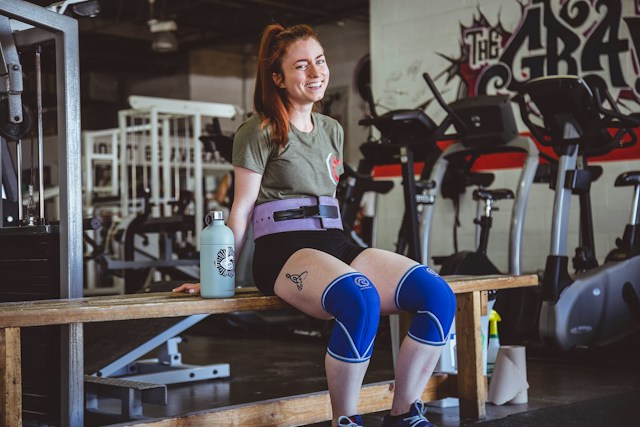Progressive overload means slowly adding more challenge to your workouts. It helps you get stronger, have more endurance, and build muscle. This method is special because it lets you increase your effort bit by bit safely.
Your lower back is very important when you do deadlifts. It helps a lot but can get hurt easily, especially if you lift too much weight incorrectly. Many weightlifters hurt their lower backs, so learning how to avoid this is important.
In this blog, we’re going to teach you how to add more challenge to your deadlift exercises safely. We’ll focus on how to keep your lower back safe and healthy while you get stronger. This is also a good place to learn more about caring for your back when lifting weights.
Understanding the Deadlift
A. Anatomy of the Deadlift
Deadlifting works out many muscles in your body, like your glutes (butt muscles), hamstrings (back of your thighs), lower and upper back, and your core (tummy muscles). It’s really important to know how to lift the right way. This helps you use all these muscles well and keeps you from getting hurt.
B. Common Causes of Lower Back Strain in Deadlifting
Lower back strain often results from incorrect form, such as rounding the back, rapid and uncontrolled weight increases, and inadequate warm-up. Sports medicine insights highlight these as common contributors to deadlift-related injuries.
C. The Role of Proper Form and Technique
Proper deadlift form involves a neutral spine, engaged core, and controlled movements. Mastering this technique is crucial for injury prevention and maximizing the efficacy of the exercise.
Progressive Overload Explained
A. Definition and Importance in Strength Training
Progressive overload involves systematically increasing the demands on the musculoskeletal system to gain muscle strength and endurance continually. It’s fundamental for consistent improvement in strength training.
B. How Progressive Overload Works in Deadlifts
In deadlifting, progressive overload can be applied by increasing weights, altering rep and set counts, and varying the lifting technique. This approach ensures continuous muscle adaptation and growth.
C. The Balance Between Intensity and Safety
The key to successful progressive overload lies in balancing the intensity of workouts with safety, ensuring that increases in weight or complexity do not compromise form or lead to injury.
Techniques for Progressive Overload in Deadlifts
A. Gradual Increase in Weights
1. Tips for Safe Weight Increment
Following a structured plan, it’s recommended to increase weights in small, manageable increments. Percentage-based increases are effective for maintaining control over workload intensity.
2. Monitoring Your Progress
Keeping track of weight progression helps assess improvement and set future goals. Progress can also be evident through enhanced endurance, strength, and stability.
B. Altering Repetition and Set Structure
1. Varying Reps and Sets for Progressive Overload
Adjusting the number of reps and sets is a strategic way to introduce variety and challenge in training. This variation helps in overcoming plateaus and continuous muscle development.
2. Examples of Effective Set and Rep Schemes
A simple 5×5 scheme (five sets of five reps) can be effective for beginners. Intermediate and advanced lifters might employ more complex schemes, like pyramid or drop sets.
C. Utilizing Different Deadlift Variations
1. Sumo, Conventional, and Romanian Deadlifts
Each deadlift variation places different demands on the lower back. Understanding these nuances can help select the most appropriate style for individual needs.
2. How Each Variation Affects the Lower Back
For instance, sumo deadlifts can reduce the strain on the lower back due to a more upright torso position, whereas conventional deadlifts require more lower back engagement.
D. Incorporating Accessory Exercises
1. Strengthening Supporting Muscles
Strengthening muscles that support the deadlift, like the core and glutes, can significantly reduce the risk of lower back strain.
2. Recommended Accessory Exercises
– Exercises like hip thrusts, planks, and back extensions are beneficial in building strength in areas crucial for a safe and effective deadlift.
Additional Strategies for Reducing Lower Back Strain
A. Importance of a Comprehensive Warm-Up
– Engaging in a thorough warm-up routine prepares the muscles and joints for the stress of deadlifting, reducing the risk of strain.
B. Stretching and Mobility Work
Regular stretching and mobility exercises improve flexibility and range of motion, which is crucial for maintaining proper form during deadlifts.
C. Core Strengthening Exercises
A strong core stabilizes the spine during lifting, protecting the lower back. Incorporating exercises like planks and leg raises can enhance core strength.
D. Recovery and Rest Days
Rest and recovery are essential for muscle repair and growth, preventing overuse injuries. Planning rest days and active recovery sessions helps maintain a healthy training balance.
Equipment and Gear for Safe Deadlifting
A. Choosing the Right Footwear
Stability and posture during deadlifts can be significantly influenced by footwear. Flat-soled shoes or specialized weightlifting shoes are often recommended for optimal performance.
B. Benefits of Weightlifting Belts
Weightlifting belts support the lower back, especially during heavy lifts. Understanding when and how to use them effectively is important for safety.

C. Other Useful Gear: Wrist Straps, Knee Sleeves
Wrist straps can aid in grip, while knee sleeves offer joint support, contributing to a safer lifting environment.
Common Mistakes to Avoid
A. Overloading Too Quickly
Rapidly increasing the weight without proper adaptation can lead to strain and injury. It’s important to progress at a pace that the body can handle.
B. Neglecting Form and Posture
If you’re experiencing lower back pain after deadlift, it could be a sign of consistently poor form. This can lead to chronic injuries and slow down your progress in weightlifting.
It’s really important to focus on using the right technique rather than just trying to lift heavier weights. Proper form helps prevent lower back pain after deadlift and keeps you safe and healthy while you get stronger.
C. Ignoring Pain and Discomfort
While muscle fatigue is normal, pain and discomfort indicate potential injury. Listening to these signals is essential for long-term health and progress.
Tracking Progress and Adjusting Your Approach
A. Keeping a Training Log
A detailed training log helps track progress, identify patterns, and make informed adjustments to training routines.
B. Listening to Your Body
Being attuned to the body’s response to training helps recognize when to push harder or scale back.
C. When to Seek Professional Advice
Consulting with fitness professionals, such as trainers or physiotherapists, is beneficial, especially when facing plateaus or persistent discomfort.
Conclusion
This blog has shared tips for safely adding weight and challenge to your deadlift exercises. We focused on ways to keep your lower back safe. We talked about how to do deadlifts correctly, slowly adding more weight, and paying attention to what your body tells you.
Featured Photo by Danielle Cerullo on Unsplash

